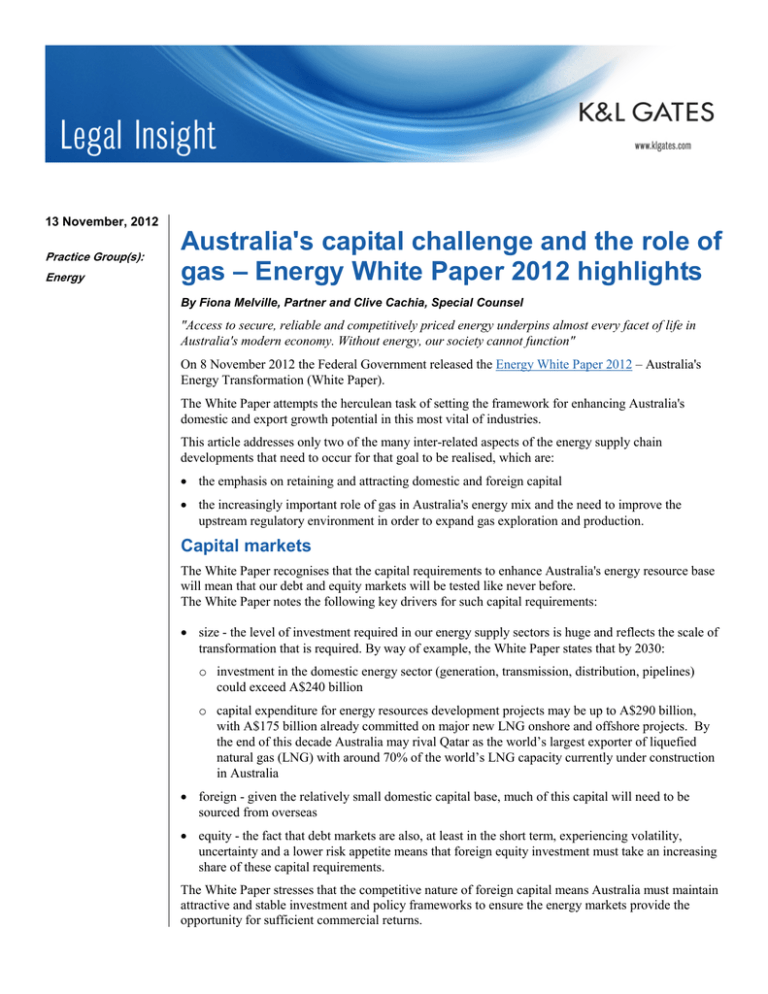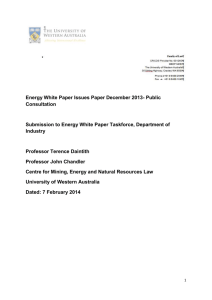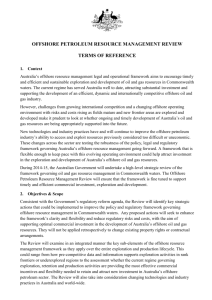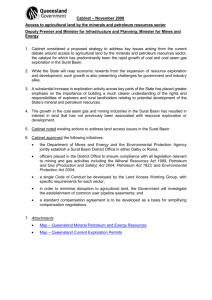
13 November, 2012
Practice Group(s):
Energy
Australia's capital challenge and the role of
gas – Energy White Paper 2012 highlights
By Fiona Melville, Partner and Clive Cachia, Special Counsel
"Access to secure, reliable and competitively priced energy underpins almost every facet of life in
Australia's modern economy. Without energy, our society cannot function"
On 8 November 2012 the Federal Government released the Energy White Paper 2012 – Australia's
Energy Transformation (White Paper).
The White Paper attempts the herculean task of setting the framework for enhancing Australia's
domestic and export growth potential in this most vital of industries.
This article addresses only two of the many inter-related aspects of the energy supply chain
developments that need to occur for that goal to be realised, which are:
• the emphasis on retaining and attracting domestic and foreign capital
• the increasingly important role of gas in Australia's energy mix and the need to improve the
upstream regulatory environment in order to expand gas exploration and production.
Capital markets
The White Paper recognises that the capital requirements to enhance Australia's energy resource base
will mean that our debt and equity markets will be tested like never before.
The White Paper notes the following key drivers for such capital requirements:
• size - the level of investment required in our energy supply sectors is huge and reflects the scale of
transformation that is required. By way of example, the White Paper states that by 2030:
o investment in the domestic energy sector (generation, transmission, distribution, pipelines)
could exceed A$240 billion
o capital expenditure for energy resources development projects may be up to A$290 billion,
with A$175 billion already committed on major new LNG onshore and offshore projects. By
the end of this decade Australia may rival Qatar as the world’s largest exporter of liquefied
natural gas (LNG) with around 70% of the world’s LNG capacity currently under construction
in Australia
• foreign - given the relatively small domestic capital base, much of this capital will need to be
sourced from overseas
• equity - the fact that debt markets are also, at least in the short term, experiencing volatility,
uncertainty and a lower risk appetite means that foreign equity investment must take an increasing
share of these capital requirements.
The White Paper stresses that the competitive nature of foreign capital means Australia must maintain
attractive and stable investment and policy frameworks to ensure the energy markets provide the
opportunity for sufficient commercial returns.
Australia's capital challenge and the role of
gas – Energy White Paper 2012 highlights
The White Paper notes a range of broad policy implications of these drivers including:
• privatisation – of government owned energy infrastructure on the basis that continued government
ownership of energy businesses impedes greater competition and efficiency, and reduces market
confidence by creating uncertainty and risk for private sector investors
• deregulation – of retail energy prices where effective competition exists noting that setting
regulated prices below the cost of supply (as has happened in Queensland and Western Australia)
is not in the long term interest of consumers because it ultimately leads to sharper catch up costs
and loss of competition in the market.
• regulatory reform – of upstream gas markets and in particular:
o those elements within the Commonwealth Government's immediate influence (ie offshore gas
exploration and production)
o those aspects which are currently politically sensitive (coal seam gas exploration and
production).
• four yearly reviews of broader energy policy issues.
The White Paper states that the Commonwealth Government will advance these reforms through the
Standing Council of Energy and Resources (SCER - comprising Commonwealth, state and territory
energy and resources ministers) in cooperation with the States and Territories.
There are many other broader, non-energy market specific policy implications of such investment
requirements which will need to be explored but which are outside the scope of the White Paper.
These include improving transparency in foreign investment regulation and reform of fundraising laws
(although recent initiatives in promoting the corporate debt market are welcome).
The importance of gas
The White Paper contains different estimates of growth of Australia's gas production, (the first that it
is projected to quadruple by 2017 and the second by 2035), driven by the growth of our LNG export
industry. There is also potential for substantial growth in domestic demand. This projected growth is
attributed to its attractiveness in terms of lower prices and environmental benefits relative to some
other non-renewable energy sources. It means that gas will increasingly replace liquid fuels in
domestic and international electricity generation, transportation and fuel or feedstock for downstream
industries. The need to develop Australia's significant gas reserves and to reverse Australia's declining
share of international resource exploration expenditure has lead to a couple of headline regulatory
initiatives by the Commonwealth Government.
1. Offshore petroleum regulatory reform
While onshore resource related activities are generally the responsibility of state and territory
jurisdictions through relevant government departments, offshore petroleum activities in Australia are
regulated by Commonwealth, State and Northern Territory Governments. Like the onshore petroleum
regulatory regime, this offshore legislative framework aims to provide an orderly exploration and
2
Australia's capital challenge and the role of
gas – Energy White Paper 2012 highlights
production of petroleum resources and sets out the rights, entitlements and responsibilities of
government and industry. The legislation provides for a system of petroleum exploration, retention
and production licence arrangements as well as core environmental, operation and safety regulation.
With the objective to remove the duplication and inconsistent administration of offshore and onshore
petroleum activities, the following new Commonwealth Statutory Agencies have commenced
operations from 1 January 2012:
• National Offshore Petroleum Safety and Environmental Management Authority (NOPSEMA) – an
independent national regulator which regulates occupational health and safety, day to day
petroleum operations, structural integrity of facilities, wells and well related equipment, and
environmental management of all offshore petroleum activities in Commonwealth Waters, and in
coastal waters where State powers have been conferred
• National Offshore Petroleum Titles Administrator (NOPTA) –has responsibility for the
administration of all offshore petroleum titles, undertaking data and resource management, and
providing technical advice to joint authorities
Offshore retention leases serve a critical function to encourage explorers to work in commercially
challenging areas by providing a longer window of tenure security in which to bring discoveries into
development. However, the White Paper recognises that reform is needed to promote greenfields
exploration in an environment of volatile and rising energy prices, game-changing technologies such
as deep water drilling and floating LNG and highly capital intensive and long term LNG
developments. While noting that retention leases should not lead to warehousing of petroleum
resources, the White Paper clearly recognises that tenure certainty and security will be increasingly
important to attract investment.
The establishment of NOPTA is expected to:
• provide greater certainty about approval timeframes, parameters for ministerial decisions,
commerciality tests (for the grant and renewal of retention leases) and triggers for review
• significantly reduce the unnecessary regulatory burden on the petroleum sector (a concern raised in
the Productivity Commission Review of Regulatory Burden on the Upstream Petroleum (Oil &
Gas) Sector in 2009), provide consistent work programmes and monitoring to ensure barriers to
commercialising resources are addressed
• enhance transparency of the retention lease system and provide access to non-confidential
information. This aims to better facilitate third party comments on applications and the promotion
of alternative development options if projects are not progressed in a timely manner.
Further, the White Paper flags the Commonwealth Government's willingness to explore a "project
title" concept to provide reserve certainty for highly capital intensive projects over long timeframes
(30 years plus). This will balance the need for certainty with other pressures including promoting
commercial domestic gas supply.
2. Upcoming reform of coal seam gas
The emphasis on gas development is likely to focus on the opportunity afforded by significant coal
seam gas deposits in New South Wales and Queensland. In this context, the Commonwealth
3
Australia's capital challenge and the role of
gas – Energy White Paper 2012 highlights
Government is currently working with those states (and others) to harmonise the coal seam gas
regulatory regime nationally.
It is well known that there are significant community concerns regarding coal seam gas which largely
centre on exploration and extraction access rights and the actual or potential adverse effects on
agricultural production and water resources including subterranean aquifers.
On 9 December 2011 the Commonwealth Government, through SCER, initiated a programme to
develop and implement a national harmonised framework for coal seam gas to address key areas of
community concern:
• water management and monitoring
• hydraulic fraccing and chemical use
• well integrity and aquifer protection
• multiple land use and co-existence
• best practice standards.
The work programme for this harmonisation process can be summarised as follows:
• consultation and development - in consultation with state and territory governments, develop and
agree on the proposed policy statement, work programme, summary of activities in place or being
progressed by such governments and the community engagement and communications strategy
• research and analysis - a stock take of existing Australian regulatory regimes of coal seam gas
wells in each jurisdiction and a stock take of current Australian Government and industry
practices, procedures and reporting requirements to determine common ground and where gaps
may exist within and between jurisdictions
• identification of elements for a leading best practice approach
• drafting of the harmonised framework to address the areas of concern noted above.
A draft Framework was targeted for release in September 2012 with completion scheduled for
December 2012. That program has slipped and we expect an update on its progress will be made at the
next SCER meeting so we will keep you informed of these developments. The SCER harmonisation
of coal seam gas regulation and the upcoming Productivity Commission review into non-financial
barriers faced by exploration companies all point to 2013 being a year which promises significant
change in the functioning of our energy markets.
Authors:
Fiona Melville
Fiona.melville@klgates.com
+61.2.9513.2498
Clive Cachia
Clive.cachia@klgates.com
+61.2.9513.2515
4
Australia's capital challenge and the role of
gas – Energy White Paper 2012 highlights
Anchorage Austin Beijing Berlin Boston Brisbane Brussels Charleston Charlotte Chicago Dallas Doha Dubai Fort Worth Frankfurt
Harrisburg Hong Kong London Los Angeles Melbourne Miami Milan Moscow Newark New York Orange County Palo Alto Paris Perth
Pittsburgh Portland Raleigh Research Triangle Park San Diego San Francisco São Paulo Seattle Seoul Shanghai Singapore Spokane
Sydney Taipei Tokyo Warsaw Washington, D.C.
K&L Gates includes lawyers practicing out of 47 fully integrated offices located in North America, Europe, Asia,
South America, Australia, and the Middle East, and represents numerous GLOBAL 500, FORTUNE 100, and
FTSE 100 corporations, in addition to growth and middle market companies, entrepreneurs, capital market
participants and public sector entities. For more information about K&L Gates or its locations and registrations, visit
www.klgates.com.
This publication is for informational purposes and does not contain or convey legal advice. The information herein should not be used or relied upon in
regard to any particular facts or circumstances without first consulting a lawyer.
©2013 K&L Gates LLP. All Rights Reserved.
5








